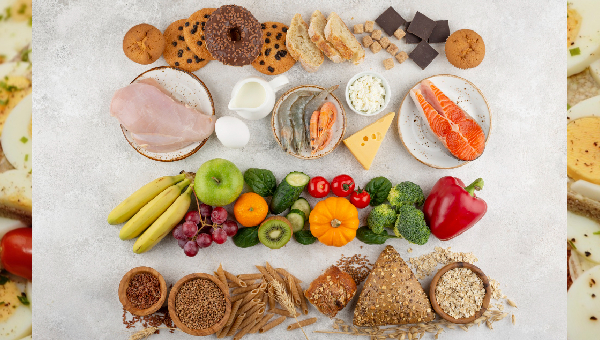Don’t Just Drink Milk: 10 Unexpected Foods High in Calcium

People traditionally link calcium thoughts with a glass of milk. The calcium content of dairy products is high but alternative and better mineral sources exist beyond these products. The vital role of calcium sustain bone strength and operate both muscles and nerves besides managing heart functions. People are mostly concerned about their calcium intake, especially among those who face lactose intolerance or practice plant-based eating. Several foods which do not contain dairy items contain surprising levels of calcium. The following list presents ten unexpected calcium-rich foods which enable people to satisfy their daily requirements without requiring milk consumption.
Canned Sardines
Sardines contain such high calcium content that you would not expect this from these small fish. The canned sardines retain all their tiny but edible bones that hold abundant calcium content.
Sardines deliver a nutritious quantity of vitamin D and omega-3 fatty acids together with calcium so your body better uses this important mineral. Sardines can be added to various seafood meals like salads and pasta and you can consume them with crackers as a nutritious seafood dish. People who dislike the taste of sardines should consider mixing them with robustly flavoured food as a gentle way to add sardines to their meals.
Tofu (Especially When Calcium-Set)
The protein-rich food tofu adapts well to various flavour profiles because it functions as an excellent calcium supplement. The calcium-set version containing calcium sulfate represents your best option when selecting this food.
Consumers who follow vegetarian or vegan diets commonly use tofu because it works well in many types of dishes although its most common usage happens in stir-fries and curries and smoothies. Verify the nutritional label to make sure the tofu uses calcium salts as its setting agent. A combination of cooked tofu with calcium-rich vegetables or ingredients creates a meal which provides a double portion of this mineral.
Chia Seeds
The powerful trio of calcium and omega-3 fatty acids and fiber exists inside these miniature chia seeds. Chia seeds offer a calcium content equivalent to two tablespoons which exceeds the levels found in a glass of milk.
Chia seeds enhance the nutritious value of oatmeal and smoothies as well as puddings and yogurt. The texture of these seeds transforms into a firm jelly structure after soaking so they serve as creative dietary elements in both sweet and savoury morning foods and desserts. The combination of one tablespoon of chia seeds with three tablespoons of water creates a suitable egg replacement for baking without animal products.
Almonds
Almonds are by far the best nuts when it comes to their calcium content. The nutritional package includes protein as well as healthy fats and vitamin E.
The same almond servings facilitate raw consumption and provide choices for salad and granola mix-ins or lid use between toast pieces. Maintain controlled consumption because almonds contain high amounts of calories. The use of almond flour provides a way to hide calcium in gluten-free baked items such as cookies, pancakes and muffins.
Collard Greens
When properly cooked collard greens give a strong calcium boost while becoming easier to eat because of volume reduction.
Consumers can prepare tasty side dishes from collard greens by sauteeing them with garlic, olive oil and spices. You can use cooked collard greens as a component in soups and stews and they work well as a wrap ingredient too. Kale and turnip greens together with bok choy provide a similar amount of calcium when collard greens are not easily accessible.
White Beans
White beans particularly cannellini contain calcium along with other nutrients which makes them another good plant-based source of the mineral. They contain protein together with iron as well as calcium and fibre.
White beans are incredibly versatile. White beans work well when prepared as part of soups, stews, salads or dip ingredients. These affordable food items can stay ready for use because they exist in both canned and dried forms. White beans provide enough calcium for you to prepare creamy spreads that serve as replacements for both hummus and mayonnaise.
Figs (Dried)
The chewy sweet dried fig contains unexpectedly high levels of calcium. The nutritious benefits of dried figs include antioxidant content and fibre together with their high calcium value.
Consumers can enjoy dried figs either by themselves blend them with oats or yoghurt or mix them into baked foods. As they contain natural sweetness dried figs become an ideal option for combating sugar cravings healthily. A mix of dried figs with almonds and dark chocolate creates a trail mix that delivers a calcium boost through its ingredients.
Seaweed (Wakame)
Many Asian cuisines use seaweed as a well-loved culinary component although it remains unfamiliar to many people as the wakame variety is an excellent source of calcium.
Wakame functions as an addition for both miso soup and salads and rice dishes. You can find three important minerals in seaweed wakame alongside calcium: magnesium, iodine and folate which create a nutritious eating option. Seaweed snacks have become mainstream products which make it easy to add sea vegetables to your eating habits.
Fortified Plant-Based Milks
Many individuals do not recognize that fortified non-dairy milks serve well as calcium sources even though they do not surprise people like sardines or seaweed. Company-made almond soy oat and rice milk products receive added calcium that can match or exceed the quantity found in regular milk. Normally this will come out to between 300 and 450 milligrams for an 8-ounce serving. Confirm by reading the label because fortified drinks exist in the market. People can use these plant-based dairy alternatives exactly like regular milk while preparing cereal or smoothies and drinking them in coffee along with using them in cooking. Vitamin D and B12-fortified plant-based milk sold by specific brands become complete nutrition options available to vegans.
Blackstrap Molasses
Although blackstrap molasses no longer takes up space in most kitchens it previously served as a preferred sweetening ingredient in the past. The syrup contains substantial amounts of both iron and calcium besides its characteristic dark colour. Blackstrap molasses finds its uses in baking as in gingerbread recipes and also works as a drizzle for oatmeal or as a health tonic when stirred with warm water and lemon juice. The deep rich flavor emerges as a result of using this ingredient in any dish. People use Blackstrap molasses in natural remedies following its high mineral concentrations.
Why Calcium Matters—And How Much You Need
The human body needs calcium as this mineral plays an active role in the development of bone and teeth and the control of blood-clotting mechanisms nerve functions and muscle-tensing functions. When the diet fails to supply adequate calcium, the mineral is withdrawn from the bones, which can lead to low bone mass over the years and an increased risk of osteoporosis. So many people fall short of calcium intake, especially if dairy is avoided. However, with a diet that comprises both dairy and non-dairy sources, adequate calcium intake can be achieved with relative ease. The calcium needs might be elevated in a pregnant or lactating person, an individual with a medical condition, or someone on medications that impair calcium absorption. Recommended Daily Intake:
- An adult 19–50 years: 1,000 mg
- For over the age of women 50 and men, 70 both should consume at least 1200 mg
- Teens 9-18 years old: 1,300 mg
Tips to Maximize Calcium Absorption
The amount of calcium in your food fails to explain how your body absorbs it effectively since absorption matters more than food intake values. Here are some quick tips:
- Vitamin D causes calcium from foods to be more effectively absorbed by the body. Consumption of sunlight, fatty fish and eggs together with fortified foods can help the body absorb calcium effectively.
- Both caffeine and soda act against your body in two ways: calcium absorption decreases while the bones slowly lose their calcium content.
- Food items abundant in magnesium enable better calcium absorption into the body. Seeds along with nuts as well as whole grains and leafy greens constitute excellent dietary sources.
- Throughout your day consume small amounts of calcium in divided doses for better absorption by your body.
- You should watch out for the substances oxalates and phytates present in spinach along with beet greens and specific grains which can minimize calcium absorption by forming bonds with calcium in the body. Heat treatment methods apply benefits toward minimizing their impact on calcium digestion.
Conclusion
Dairy products such as milk provide valuable calcium nutrition which people can acquire from other food sources besides milk. Any person with lactose intolerance or vegan restrictions or anyone who wants nutrition diversity can use these 10 unexpected food options to achieve their daily calcium goals. People looking to enjoy calcium in their diet can easily find options beyond dairy products because they can turn to a large collection of foods starting from basic fish to nutritious seeds. It is wise to consume calcium through your diet rather than just drinking it.
Must read this: Juice Up Your Mornings: A Fresh Start for a Healthier You








